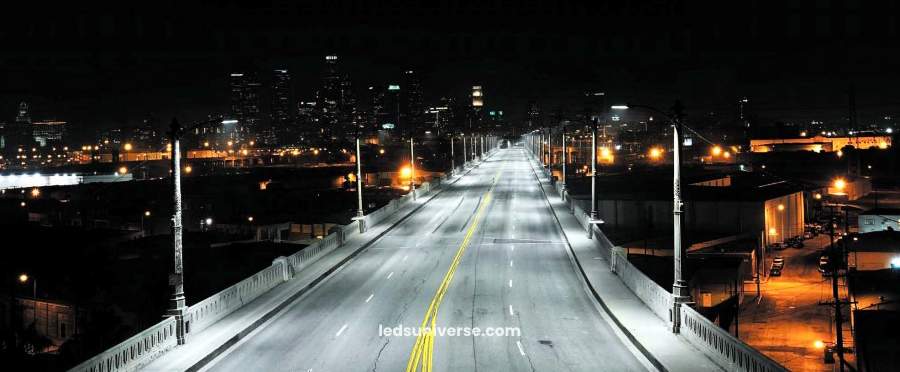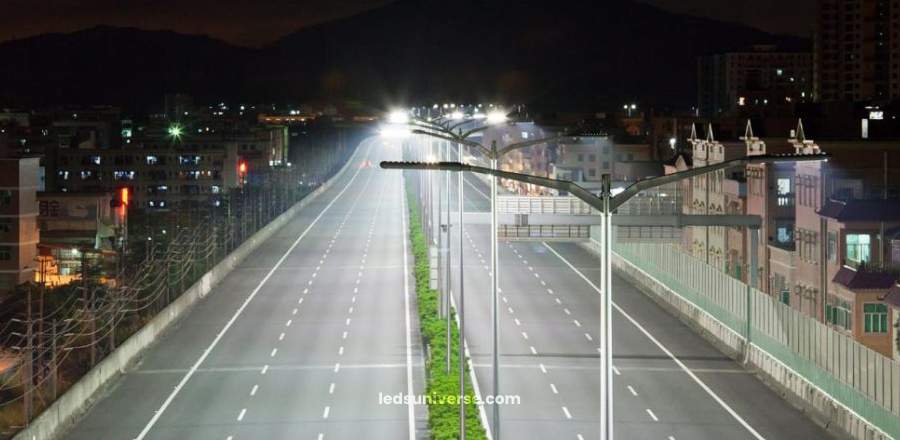With the rise of advanced lighting technologies, the traditional approach to highway illumination is undergoing a transformative shift. Enter LED technology—revolutionizing how we light up highways with its unparalleled efficiency, durability, and brilliance.
Effective highway lighting improves driver perception, reduces accidents, and enhances overall road safety. In designing a highway lighting system, several factors must be considered to determine the appropriate number of lights and their distribution. Factors influencing the number of lights needed, the importance of uniformity, and other relevant considerations for optimal highway lighting are discussed.
Reach out for free lighting consultation
Table of Contents
Toggle
Roads with multiple lanes, sharp curves, and intersections often need more lighting to ensure clear visibility for drivers. The lighting design must accommodate these factors by providing adequate illumination along the entire length of the road, including areas where visibility may be compromised due to road design features.
Highways with high traffic volumes or higher speed limits generally require more lighting. The increased number of vehicles and higher speeds demand better visibility to prevent accidents and ensure safe driving conditions. Lighting systems must be designed to provide sufficient illumination to accommodate varying traffic conditions and speeds, ensuring that drivers can react promptly to any obstacles or hazards.
The type of lighting technology and fixtures used also influences the number of lights needed. LED fixtures, for example, are highly efficient and provide bright, uniform light with lower energy consumption compared to traditional high-intensity discharge (HID) lamps. The choice of lighting technology affects the spacing and quantity of fixtures required to achieve the desired illumination levels and coverage.
Environmental factors such as weather conditions and geographical features can impact the effectiveness of highway lighting. In regions with frequent fog, rain, or snow, lighting systems must be designed to penetrate these conditions and maintain visibility. Additionally, geographical features like hills or valleys may require specialized lighting solutions to ensure even illumination across the roadway.
Uniformity in highway lighting is crucial for maintaining consistent visibility and reducing glare. Uneven lighting can create dark spots and areas of excessive brightness, leading to discomfort and potential hazards for drivers. Achieving uniform illumination ensures that the entire roadway is adequately lit, providing a safer driving environment and improving overall road safety.
To achieve uniform lighting, careful consideration must be given to fixture placement, spacing, and light distribution. Using lighting fixtures with proper beam angles and optical designs helps distribute light evenly across the road surface. Additionally, employing advanced lighting control systems can adjust light levels dynamically based on traffic conditions and environmental factors, enhancing uniformity and energy efficiency.
Uniform lighting also affects driver perception and reaction times. Consistent illumination reduces the likelihood of sudden contrasts between well-lit and poorly lit areas, allowing drivers to navigate the highway more comfortably. Properly designed lighting systems enhance visual acuity, making it easier for drivers to detect road signs, obstacles, and other vehicles.

The appropriate lux level for highway lighting varies depending on several factors, including road type, traffic volume, and environmental conditions. For high-speed roads and highways, a higher lux level is required to ensure that drivers can see clearly and react promptly to any obstacles or hazards. Generally, highways are designed to achieve a lux level ranging from 20 to 50, which provides sufficient brightness for safe navigation and visibility. This level ensures that drivers have a clear view of the road, road signs, and other vehicles, minimizing the risk of accidents.
Insufficient lighting can lead to poor visibility, making it difficult for drivers to see road signs, lane markings, and other vehicles. This can increase the likelihood of accidents, especially in high-speed areas where quick reactions are necessary. Conversely, overly bright lighting can cause glare and discomfort, potentially affecting driving performance. Therefore, achieving the right balance in lux levels is essential for creating a safe driving environment.
To achieve the desired lux levels on highways, careful consideration must be given to the design and placement of lighting fixtures. The choice of lighting technology, such as LED or high-intensity discharge lamps, can impact the effectiveness of illumination. LEDs, for example, offer high efficiency and brightness, making them suitable for achieving the necessary lux levels while minimizing energy consumption. Proper fixture placement and spacing are also crucial; fixtures must be strategically positioned to ensure even light distribution and avoid dark spots.
One key feature of modern highway lights is their significant enhancement of safety, reduction in the night-to-day crash ratio, and improved intersection safety. LED street lights, characterized by their use of light-emitting diodes (LEDs), have revolutionized lighting technology in recent times. The transition to LED lights for highways has showcased numerous advantages over traditional fluorescent and high-intensity lamps. These advantages include lower energy consumption, longer lifespan, quick start-up and shut-down capabilities, and immediate restart, all while complying with RoHS regulations.
Among the standout features of our LED highway luminaires is their exceptional ground luminance reach. Our LED highway lights excel due to their multi-directional light beam and premium optical lens system, resulting in a high lumen level per watt. This makes our lights some of the brightest in the industry, eliminating shadowy spots on the streets and ensuring thorough illumination.
Another remarkable attribute is the open design of our LED lights, which facilitates ultra-cooling through an air gap between modules and offers airstream resistance. The anti-glare system further enhances visibility for motorists at night, reducing the likelihood of accidents caused by reduced visibility.
Our LED lights for highways come with diverse wattage options, tailored to meet various roadway lighting control needs depending on the altitude and distance between pillars. The adjustable installation angle is a notable feature, allowing for flexible placement at different angles in lighted intersections and highway interchanges.
Installation is simplified by the easy cable connecting design of our LED street lights, making it a user-friendly choice for industry professionals. This characteristic streamlines the installation process and minimizes associated labor.
Our LED highway lights are cost-effective, offering low maintenance costs and up to 70% energy savings compared to traditional light sources. They are also environmentally sustainable, featuring second-generation direct heat path technology for superior dissipation and LED junction cooling.
As leaders in the LED highway lighting industry, our products stand out due to their practical characteristics and numerous certifications, including ETL, TUV, CE, and RoHS. While many LED highway lights may meet RoHS compliance, our commitment to obtaining additional certifications reflects our dedication to meeting market demands in regions such as Germany, the US, and the UK.
Our LED control unit street lights are designed to repel nocturnal insects, a common issue with fluorescent and high-intensity lamps. This feature adds to their overall effectiveness, ensuring that light output remains consistent and focused on desired areas.
When comparing LED lights with conventional sources, the superior light output and directionality of LEDs make them a compelling choice. Their high light output ensures that specific areas on the road are illuminated effectively, benefiting both short-term and long-term projects.
Our LED highway lights offer a combination of advanced technology, cost savings, and environmental benefits. They represent a significant improvement over traditional lighting sources, providing enhanced performance, safety, and efficiency. With features such as high luminance, versatility, and ease of installation, our LED lights are a valuable investment for any highway lighting project.